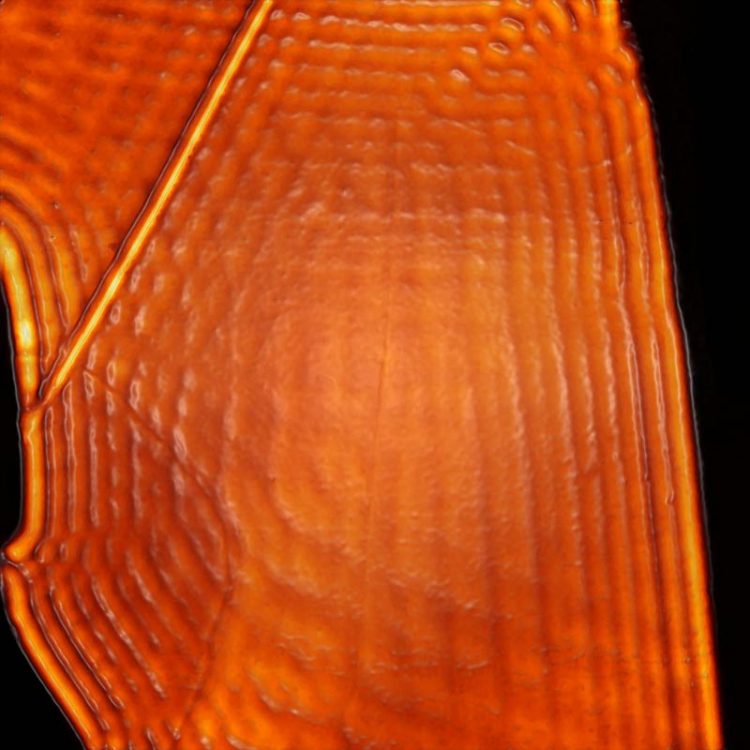NRL improves optical efficiency in nanophotonic devices

Image shows directly measured polaritons propagating through a flake of Hexagonal boron nitride (hBN). This material has been identified as an ideal substrate for two-dimensional materials research while also recently being demonstrated as an exciting optical material for infrared nanophotonics. Credit: (US Naval Research Laboratory)
“The applications for this research are considerably broad,” said Dr. Alexander J. Giles, research physicist, NRL Electronics Science and Technology Division. “By confining light to very small dimensions, nanophotonic devices have direct applications for use in ultra-high resolution microscopes, solar energy harvesting, optical computing and targeted medical therapies.”
Hexagonal boron nitride (hBN) forms an atomically thin lattice consisting of boron and nitrogen atoms. This material has recently been demonstrated as an exciting optical material for infrared nanophotonics and is considered an 'ideal substrate' for two-dimensional materials.
While previous work demonstrated that natural hBN supports deeply sub-diffractional hyperbolic phonon polaritons desired for applications, such as, sub-diffractional optical imaging (so-called 'hyperlensing'), energy conversion, chemical sensing, and quantum nanophotonics, limited transmission efficiencies continue to persist.
“We have demonstrated that the inherent efficiency limitations of nanophotonics can be overcome through the careful engineering of isotopes in polar semiconductors and dielectric materials,” Giles said.
Naturally occurring boron is comprised of two isotopes, boron-10 and boron-11, lending a 10 percent difference in atomic masses. This difference results in substantial losses due to phonon scattering, limiting the potential applications of this material. The research team at NRL has engineered greater than 99 percent isotopically pure samples of hBN, meaning they consist almost entirely of either boron-10 or boron-11 isotopes.
This approach results in a dramatic reduction in optical losses, resulting in optical modes that travel up to three times farther and persist for up to three times longer than natural hBN. These long-lived vibrational modes not only enable immediate advances specific to hBN – near field optics and chemical sensing – but also provide a strategic approach for other materials systems to exploit and build upon.
“Controlling and manipulating light at nanoscale, sub-diffractional dimensions is notoriously difficult and inefficient,” said Giles. “Our work represents a new path forward for the next generation of materials and devices.”
###
Contributors to this research include scientists from the University of California San Diego, Kansas State University, Oak Ridge National Laboratory, Columbia University, and Vanderbilt University. Full details of this research entitled “Ultralow-loss polaritons in isotopically pure boron nitride,” can be found in the December 11, 2017 edition of Nature Materials (doi:10.1038/nmat5047).
Media Contact
All latest news from the category: Physics and Astronomy
This area deals with the fundamental laws and building blocks of nature and how they interact, the properties and the behavior of matter, and research into space and time and their structures.
innovations-report provides in-depth reports and articles on subjects such as astrophysics, laser technologies, nuclear, quantum, particle and solid-state physics, nanotechnologies, planetary research and findings (Mars, Venus) and developments related to the Hubble Telescope.
Newest articles

NASA: Mystery of life’s handedness deepens
The mystery of why life uses molecules with specific orientations has deepened with a NASA-funded discovery that RNA — a key molecule thought to have potentially held the instructions for…

What are the effects of historic lithium mining on water quality?
Study reveals low levels of common contaminants but high levels of other elements in waters associated with an abandoned lithium mine. Lithium ore and mining waste from a historic lithium…

Quantum-inspired design boosts efficiency of heat-to-electricity conversion
Rice engineers take unconventional route to improving thermophotovoltaic systems. Researchers at Rice University have found a new way to improve a key element of thermophotovoltaic (TPV) systems, which convert heat…



